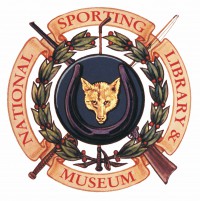The two Coming Home Series exhibitions focusing on the artist Edward Troye (American, 1808-1874), Faithfulness to Nature: Paintings by Edward Troye in the Museum and Edward Troye and His Biographers: The Archives of Harry Worcester Smith and Alexander Mackay-Smith in the Library, close on March 29, 2015. During the nineteenth century when many British animal and sporting artists enjoyed popularity in the United Kingdom, there was no one other than Troye working in the United States to rise to his caliber as an American Thoroughbred portraitist in his lifetime. Despite this, his body of work was all but forgotten by the turn of the twentieth century. The exhibitions and catalog essays cover the weighty topic of Troye’s momentous, forty-year career, the rediscovery of his paintings, and his role as a naturalist painter. If you are even mildly curious, you should visit both of these in-depth exhibits.
Today we will be taking a closer look at the Museum exhibition, Faithfulness to Nature: Paintings by Edward Troye. Forty-two works have been gathered from sixteen private and public collections that will never be organized in the same way again. Divided into three sections, the first gallery reminds the visitor of the huge impact Troye had on the racing world within the first few years of his arrival in the United States. Eleven of the fourteen works in this room were created between 1832 and 1834. In these years, Troye painted such legendary racehorses and brood mares as American Eclipse, Henry, John Singleton, and Mary Randolph.

Still in his possession when he died in 1874, Trifle, 1832, is among the first paintings that Troye completed in the United States. An early experiment with the jockey up, he did not often paint figures astride after this. The painting is also one of three compositions in the exhibition that documents the practice of keeping slaves as jockeys and trainers by Southern plantation owners before the Civil War.
The second-floor gallery offers a sweeping view of some of Troye’s most significant works created between 1839 and 1872. The 84-inch tall, A Bazaar in Damascus, 1856, is a highlight of the room. It is easy to get lost in the rich colors, vibrant details, and individual animal and figurative portraits in the highly-detailed composition.

The painting from Troye’s epic excursion to the Middle East has not been on view at eye-level under museum lighting in over a decade. When it returns to its home along with Syrian Ploughman, 1856, another mural-sized work on loan from Bethany College, they will both be rehung twenty feet in the air in the gigantic Academic Parlour of the campus’s Old Main building. (Read Bethany College’s post about the exhibition opening and loans at http://www.bethanywv.edu/about-bethany/news/2014-15-news-archive/bethany-paintings-edward-troye-showcased-middleburg-va-museu/.)
Faithfulness to Nature: Paintings by Edward Troye also features Waverly, 1872, the last known painting completed by Troye two years before he died. The landscape in it is much more fully defined than his previous works. To one side of Waverly, standing in deep shadow, is a group of horses; these are likely brood mares with two of the stallion’s progeny frolicking. To the right are a stable and tree balancing the composition.

Biographer Alexander Mackay-Smith wrote of the painting in The Race Horses of America 1832 to 1872: Portraits and Other Paintings by Edward Troye, published in 1981, “It was characteristic of the artist that only after the completion of a masterpiece was he content to put down his palette and brushes and to end his career as an artist.”
The hallway gallery punctuates the exhibition with examples of Troye’s sketches. A large painting of the winning Thoroughbred Boston (one of nine paintings generously loaned by The Jockey Club) is paired with the life study of the horse upon which it is based. There are only a handful of sketches known to still be in existence by Troye. The NSLM holds five in its permanent collection, of which Boston, 1839, is one, and the sensitive, informal charcoal study illustrated below of the aging blind Lexington, c. 1870, is another.

No picture can capture the true essence of these works. Several paintings and prints from the NSLM’s permanent collection are also on view in the Library exhibition, Edward Troye and His Biographers: The Archives of Harry Worcester Smith and Alexander Mackay-Smith. We will take a closer look at this installation in the Coming Home Series: Part 2 blog entry next week.
When these exhibitions close on March 29th, the delicate works on paper and archives will rest out of the light for a time to preserve them, and most of the paintings will leave the NSLM. Come out and visit us before the exhibits end. It will be worth your while to see them in person.
– Claudia Pfeiffer, George L. Ohrstrom, Jr. Curator of Art

One thought on “Coming Home Series, Part 1 – Faithfulness to Nature: Paintings by Edward Troye”